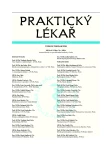Pathophysiology, symptomatology and diagnosis of an overactive urinary bladder
Authors:
R. Zachoval; M. Záleský
Authors‘ workplace:
Urologické oddělení
; Primář: Doc. MUDr. Roman Zachoval, Ph. D.
; Fakultní Thomayerova nemocnice, Praha
Published in:
Prakt. Lék. 2009; 89(10): 556-560
Category:
Various Specialization
Overview
The incidence of overactive bladder is very high; in developed countries the incidence exceeds that of such serious conditions as diabetes mellitus and depression. Etiologic factors for overactive bladder are various neurological diseases, lower urinary tract obstruction or idiopathic degeneration of the lower urinary tract. Symptomatology comprises of urgency, with or without urge incontinence, frequent voiding during the day and nocturia. Diagnosis is based on the exclusion of other pathology of the lower urinary tract (tumours, stones, inflammation) and on verification of the syndrome from patient history, physical examination, urine analysis, evaluation of post voiding residual and urodynamics.
Key words:
overactive bladder, aetiology, pathophysiology, symptomatology, diagnostic.
Sources
1. Abrams, P., Andersson, K. E. Muscarinic receptor antagonists for overactive bladder. BJU Int. 2007, 100, 5, p. 987-1006.
2. Abrams, P., Cardozo, L., Fall, M. et al. The standardisation of terminology of lower urinary tract function: report from the Standardisation Sub-committee of the International Continence Society. Neurourol. Urodyn. 2002, 21, 2, p. 167-178.
3. Brookes, S.T., Donovan, J.L., Wright, M. et al. A scored form of the Bristol Female Lower Urinary Tract Symptoms questionnaire: data from a randomized controlled trial of surgery for women with stress incontinence. Am. J. Obstet. Gynecol. 2004, 191, 1, p. 73-82.
4. de Groat, W.C. A neurologic basis for the overactive bladder. Urology 1997, 50, 6A Suppl, p. 36-52.
5. Ding, Y.Y., Sahadevan, S., Pang, W.S., Choo, P.W. Clinical utility of a portable ultrasound scanner in the measurement of residual urine volume. Singapore Med. J. 1996, 37, 4, p. 365-368.
6. Donovan, J., Bosch, R., Gotoh, M. et al. Symptom and quality of life assessment. In: Abrams, P., Cardozo, L., Khoury, S., Wein, A. Incontinence, 3rd international consultation on incontinence. Paris: Health Publication Ltd., 2004, p. 519–584.
7. Fuse, H., Yokoyama, T., Muraishi, Y., Katayama, T. Measurement of residual urine volume using a portable ultrasound instrument. Int. Urol. Nephrol. 1996, 28, 5, p. 633-637.
8. Goode, P.S., Locher, J.L., Bryant, R.L. et al. Measurement of postvoid residual urine with portable transabdominal bladder ultrasound scanner and urethral catheterization. Int. Urogynecol. J. Pelvic. Floor. Dysfunct. 2000, 11, 5, p. 296-300.
9. Hansen, B.J., Flyger, H., Brasso, K. et al. Validation of the self-administered Danish Prostatic Symptom Score (DAN-PSS-1) system for use in benign prostatic hyperplasia. Br. J. Urol. 1995, 76, 4, p. 451-458.
10. Irwin, D.E., Milsom, I., Hunskaar, S. et al. Population-based survey of urinary incontinence, overactive bladder, and other lower urinary tract symptoms in five countries: results of the EPIC study. Eur. Urol. 2006, 50, 6, p. 1306-1314.
11. Jackson, S., Donovan, J., Brookes, S. et al. The Bristol Female Lower Urinary Tract Symptoms questionnaire: development and psychometric testing. Br. J. Urol. 1996, 77, 6, p. 805-812.
12. Lazzeri, M., Porena, M. The Challange of the Overactive Bladder: From Laboratory to New Drugs. EAU-EBU Update Series 2007, 5, p. 250-258.
13. Meyhoff, H.H., Hald, T., Nordling, J. et al. A new patient weighted symptom score system (DAN-PSS-1). Clinical assessment of indications and outcomes of transurethral prostatectomy for uncomplicated benign prostatic hyperplasia. Scand. J. Urol. Nephrol. 1993, 27, 4, p. 493-499.
14. Sandvik, H., Hunskaar, S., Seim, A. et al. Validation of a severity index in female urinary incontinence and its implementation in an epidemiological survey. J. Epidemiol. Community Health 1993, 47, 6, p. 497-9.
15. Shumaker, S.A., Wyman, J.F., Uebersax, J.S. et al. Health-related quality of life measures for women with urinary incontinence: the Incontinence Impact Questionnaire and the Urogenital Distress Inventory. Continence Program in Women (CPW) Research Group. Qual. Life Res. 1994, 3, 5, p. 291-306.
16. Schroder, A., Chichester, P., Kogan, B. A. et al. Effect of chronic bladder outlet obstruction on blood flow of the rabbit bladder. J. Urol. 2001, 165, 2, p. 640-646.
17. Sibley, G.N. The physiological response of the detrusor muscle to experimental bladder outflow obstruction in the pig. Br. J. Urol. 1987, 60, 4, p. 332-336.
18. Staskin, D.R., Hilton, P., Emmanuel, A. et al. Initial Assessment of Incontinence. In: Abrams, P., Cardozo, L., Khoury, S., Wein, A. Incontinence, 3rd international consultation on incontinence. Paris: Health Publication Ltd., 2005, p. 485-518.
19. Steers, W.D. Overactive bladder (OAB): what we thought we know and what we know today. Eur. Urology Suppl. 2002, 1, 4, p. 3-10.
20. Stewart, W.F., Van Rooyen, J.B., Cundiff, G.W. et al. Prevalence and burden of overactive bladder in the United States. World. J. Urol. 2003, 20, 6, p. 327-336.
Labels
General practitioner for children and adolescents General practitioner for adultsArticle was published in
General Practitioner

2009 Issue 10
Most read in this issue
- Recombinant human erythropoietin treatment
- A new clinical unit DSD – disorders of sexual development and their consequences
- Accreditation of general practitioners‘ surgeries in the Czech Republic
- Micrometastases in the sentinel lymph node – necessity of axillar lymph node dissection?
